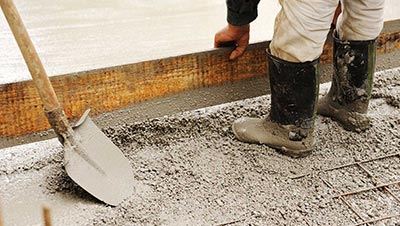What Is Considered Cold Weather?
When the average daily temperature falls below 40 degrees Fahrenheit for more than three consecutive days, it’s considered cold weather. Concrete needs special considerations for placement, finishing, curing, and protection under these conditions. Because a significant portion of the United States experiences cold weather each year, it’s important to have and follow good plans and procedures for cold weather concreting.
How Does Cold Weather Impact Fresh Concrete?
Several different cold weather specific factors affect concrete properties but understanding these factors will allow for successful placement.
Plastic Concrete Freezes
If the temperature falls below 25 degrees Fahrenheit, the concrete freezes if it’s still in a plastic state. Any freezing in this state can reduce the potential strength by more than 50 percent, along with significantly affecting the overall durability.
The propensity for plastic state concrete to freeze is why it’s important to protect the surface until the minimum compressive strength is at least 500 psi. Generally, this happens two days after placement when the concrete is kept at 50 degrees Fahrenheit.
Cement Hydration Rate Lowers
As a rule, every 20-degree drop in concrete temperature doubles the amount of time necessary for the setting. Account for a slower setting rate and strength gain when scheduling form removal and other construction operations.
Air-Entrained Concrete May Be Necessary
Use air-entrained concrete when it has contact with water and/or exposure to the freeze-thaw cycle. Remember newly placed concrete has high water saturation and needs ample insulation and protection from the freeze-thaw cycle until its compressive strength reaches at least 3,500 psi.
Adequate Insulation Is Needed For New Concrete
Because heat generates during the cement hydration reaction, newly placed concrete needs adequate insulation to retain its heat and support favorable curing temperatures. Take measures to prevent a large difference in the temperature between the surface and interior concrete as cracking often results when the difference is 35 degrees Fahrenheit or more. Gradually remove any insulation and/or protective measures to prevent thermal shock.
How To Place Concrete In Cold Weather
Most cold weather concrete procedures focus on external and internal temperatures and the direct correlation they have on the concrete curing. Heating the mixing water and/or aggregates along with furnishing the concrete under ASTM C 94 guidelines are two ways your ready mix provider can control its temperature.
Don’t Exceed Recommended Temperatures
The concrete temperature shouldn’t surpass the following temperatures by more than 20 degrees Fahrenheit:
| Section Size (in inches) | Concrete Temperature As Placed |
| > 12 | 55⁰F |
| 12 – 36 | 50⁰F |
| 36 – 72 | 45⁰F |
Cold weather concrete placement allows for the development of a higher quality concrete since a cooler initial concrete temperature usually results in higher final strength. Conversely, when the concrete has a higher temperature, it:
- Needs more mixing water;
- Has a higher rate of slump loss; and
- Is more susceptible to cracking.
Use Admixtures & Modifications To Accelerate Rate Of Setting
The use of chemical admixtures and other changes to the concrete can expedite the rate of setting and strength gain. It’s common for producers to use chemical admixtures in the winter, specifically, those which conform to ASTM C 494 Types C and E — accelerating and water-reducing and accelerating, respectively.
Although calcium chloride is a popular accelerator, never surpass two percent by weight of cement. If using prestressed concrete or in situations where contact corrosion is possible, instead use non-chloride, non-corrosive accelerators. But, keep in mind any accelerating admixture doesn’t prevent the concrete from freezing nor does the use eliminate the need for minimum concrete temperatures and adequate protection during the curing process.
Increase The Amount Of Portland Cement
Another option for bypassing the limitations of cold weather concreting is to increase the amount of Portland cement, or a Type III cement, used. Some situations may allow you to lessen the relative percentage of fly ash and/or ground slag in the cementitious material unless the mixture is specifically designed for durability.
Place Concrete At Lowest Practical Slump
Following this guideline reduces the amount of bleeding and setting time. Generally, adding one gallon to two gallons of water per cubic yard delays the set time up to two hours, and any delay extends the total bleed time.
Make Adequate Plans Before Concrete Placement
This includes all frost, ice, and snow removal prior to placing the concrete and making sure the surface temperature and any metallic embedment are above the freezing point. Insulating and/or heating the subgrade before placement may be necessary.
Have Equipment & Materials In Place To Protect Against Concrete
It’s crucial to protect the concrete from early age freezing, along with retaining the heat produced by cement hydration. Insulated blankets and tarps are frequently used as protection, but some circumstances also require enclosures and insulated forms. Remember to give appropriate attention to the corners and edges of the surface as these are most susceptible to heat loss.
Vent Fossil-Fueled Heaters
Proper venting prevents the risk of carbon monoxide and the formation of carbonation on newly placed concrete, which ultimately causes dusting.
Don’t Allow Plastic Concrete To Dry Out
Allowing the surface to dry out leads to one of the most common cold weather concrete problems, plastic shrinkage cracks. On the other hand, water curing isn’t a recommended curing method when cold weather is predicted or is occurring. Instead, using membrane-forming curing compounds and/or impermeable paper and plastic sheets for concrete slabs.
Use Insulating Blankets Or Forms In Extreme Cold
If the concrete has thin sections, these protections should be used to protect the areas from freezing. Forms should remain in place for one day to seven days, depending on the:
- Ambient conditions;
- Setting characteristics; and
- Anticipated structure load.
Use field-cured cylinders or another non-destructive method to estimate in-place concrete strength before removing the forms and/or applying loads. Don’t use field-cured cylinders as a quality assurance means.
Store Test Cylinders In Insulated Boxes
These boxes may need temperature controls to ensure the curing temperature stays within the acceptable range of 60 degrees Fahrenheit to 80 degrees Fahrenheit during the first 24 hours to 48 hours. Place a minimum/maximum thermometer inside the curing box to monitor the temperature.


